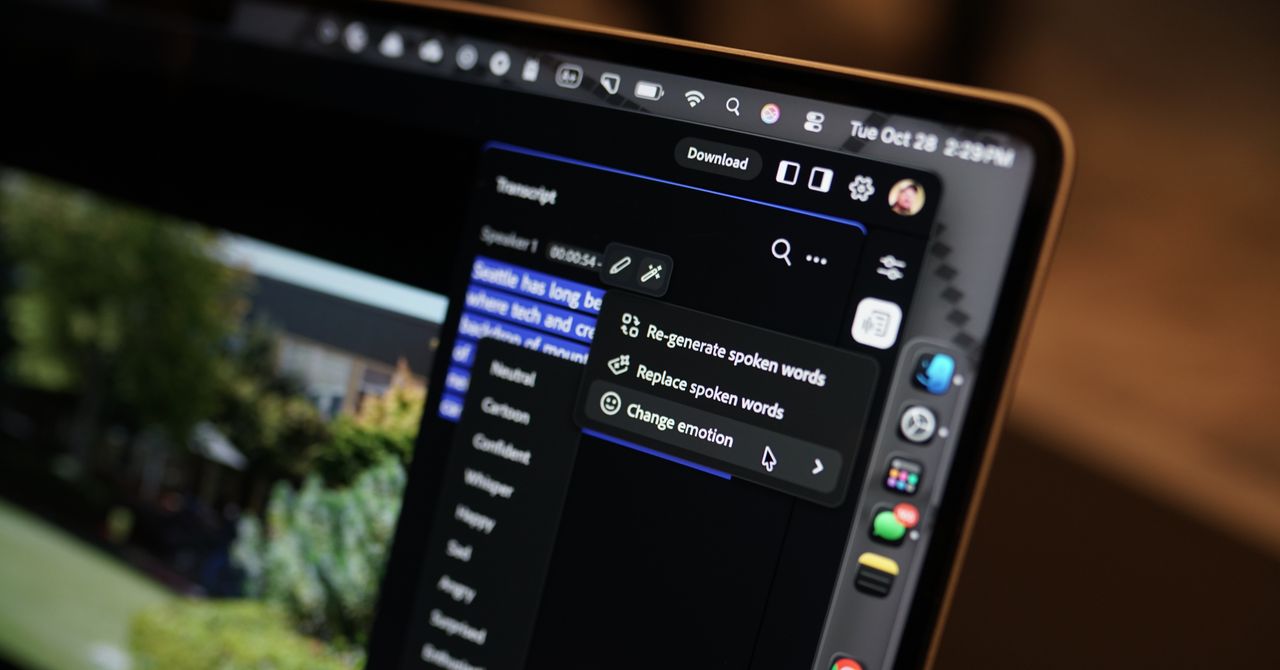Adobe Unveils Corrective AI to Transform Voice‑Over Emotion and Audio Separation

Key Points
- Corrective AI lets users change the emotional tone of existing voice‑overs instantly.
- Project Clean Take separates audio into up to five distinct tracks for precise editing.
- AI can isolate and remove unwanted background sounds, then restore them as needed.
- The system can replace copyrighted music with royalty‑free alternatives while preserving ambiance.
- Automatic sound‑effect generation matches visual scenes, with refinements via a conversational interface.
- Features are prototypes shown at MAX Sneaks and may later be integrated into Adobe Creative Cloud.
- Adobe’s AI tools aim to streamline workflows without replacing human creators.
Adobe demonstrated a suite of new AI tools at its MAX Sneaks showcase, including Corrective AI, which lets users alter the emotional tone of an existing voice‑over in seconds, and Project Clean Take, which separates audio tracks such as speech, music, and ambient sounds. The features build on recent generative speech capabilities in Adobe Firefly and aim to streamline workflows for video creators, sound designers, and editors by reducing the need for re‑recording or manual audio cleanup. Adobe also previewed AI‑driven sound‑effect generation that automatically matches scene content, highlighting the company’s push toward AI‑enhanced creative production.
Adobe’s MAX Sneaks Reveal New AI Capabilities
At the MAX Sneaks segment of its annual MAX Creativity Conference, Adobe showcased a collection of prototype tools that illustrate the direction of its upcoming AI‑driven features. The most prominent demonstration was Corrective AI, a system that allows creators to modify the emotional inflection of a pre‑recorded voice‑over without re‑recording the performance. By selecting from preset emotions, users saw a flat narration shift to confidence, whisper, and other tones within seconds.
Corrective AI extends the generative speech functions recently added to Adobe Firefly, which already supports multiple voice presets and emotion tags. Rather than producing a wholly synthetic voice, the new tool refines an existing vocal track, offering a practical workflow for editors who need quick tonal adjustments.
Project Clean Take: Advanced Audio Separation
Another prototype, dubbed Project Clean Take, demonstrated the ability to decompose a single audio recording into up to five distinct tracks, isolating elements such as spoken dialogue, ambient noise, sound effects, and background music. In one example, a speaker’s voice was overwhelmed by the sound of a drawbridge bell. After processing, the bell noise was removed, and the user could restore it at will by adjusting the separate track levels. This granular control promises to simplify on‑location shoots where unwanted background sounds often compromise audio quality.
The technology also proved useful for public‑space recordings that include licensed music. Adobe’s AI could extract the music, replace it with a similar royalty‑free track from Adobe Stock, and apply matching reverb and ambiance, thereby avoiding potential copyright strikes on platforms like YouTube.
AI‑Generated Sound Effects
Adobe illustrated an additional feature where an AI model automatically analyzes a video’s visual content, identifies scenes, and generates appropriate sound effects. For instance, the system recognized an alarm clock in a scene and produced a corresponding sound, as well as a car door closing for a driving sequence. While some generated sounds lacked realism—such as an unnatural rustling during a hug—the tool allowed creators to refine results through a conversational interface similar to ChatGPT, describing desired changes and receiving updated audio placements.
These experimental capabilities are not yet available to the public but typically progress from prototype to integration within Adobe’s Creative Cloud suite, as seen with prior features like Harmonize in Photoshop.
Implications for the Creative Industry
Adobe’s announcements arrive amid broader industry discussions about AI’s impact on creative work, including recent negotiations with video‑game voice actors regarding consent and disclosure for AI‑generated performances. By focusing on tools that augment rather than replace human talent—such as correcting existing recordings and offering selective audio manipulation—Adobe positions its AI roadmap as a means to enhance efficiency while preserving artistic intent.